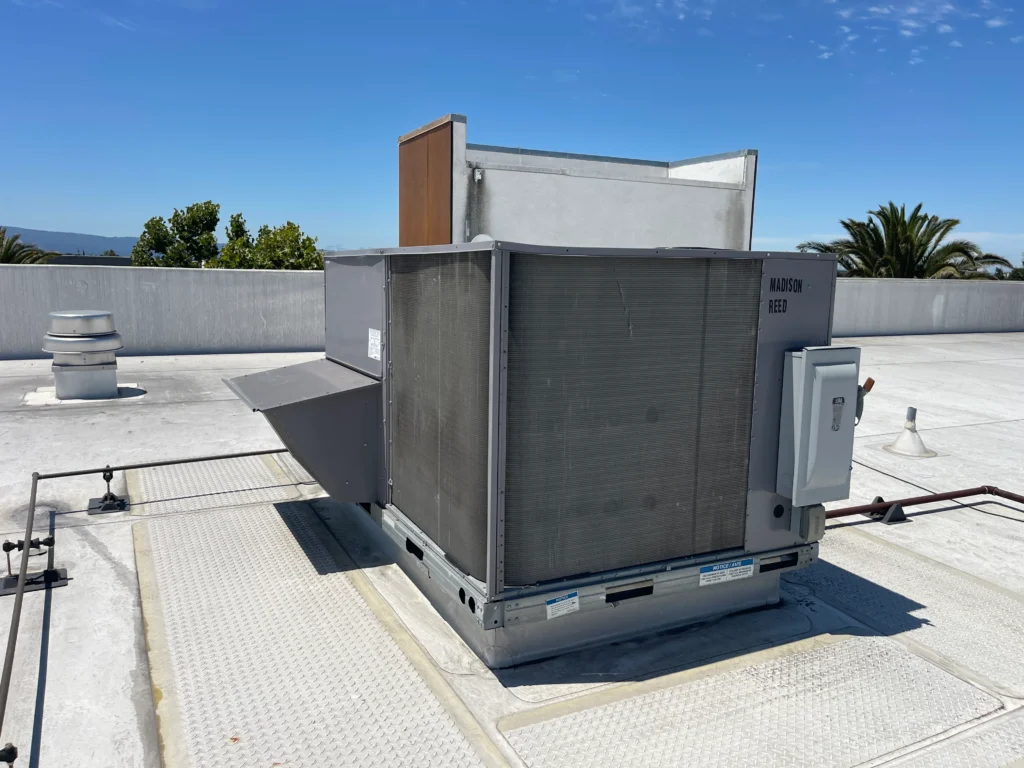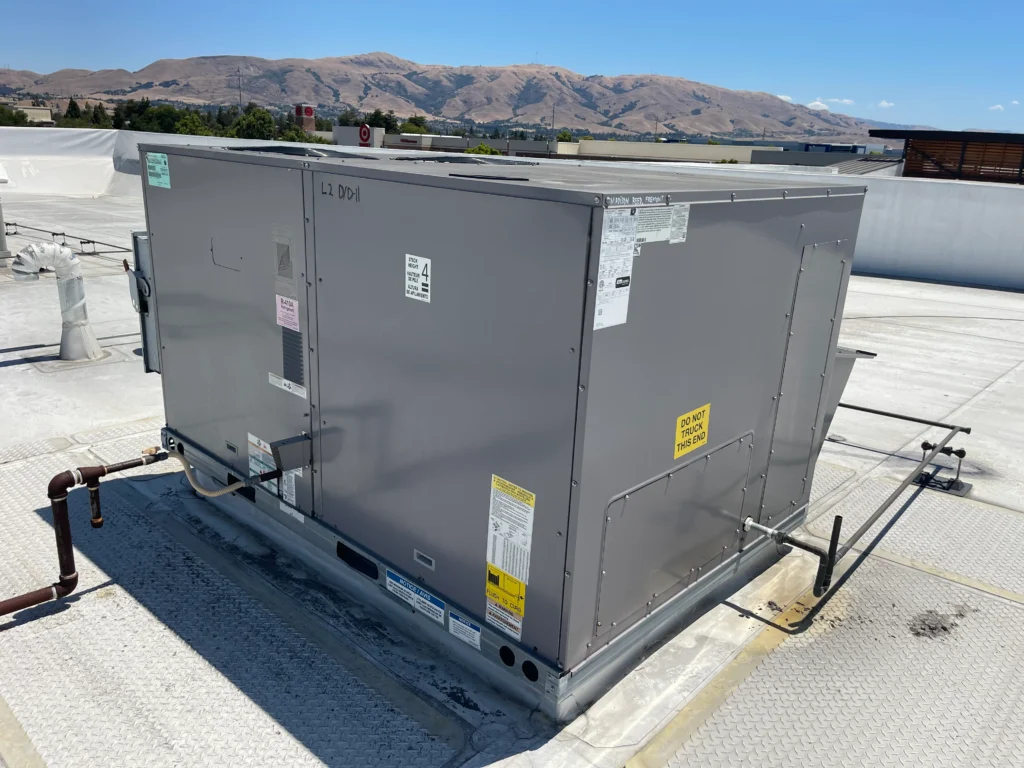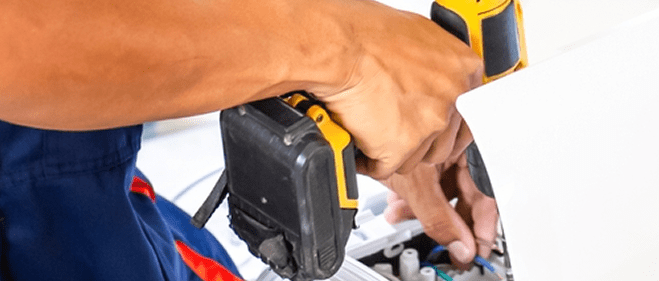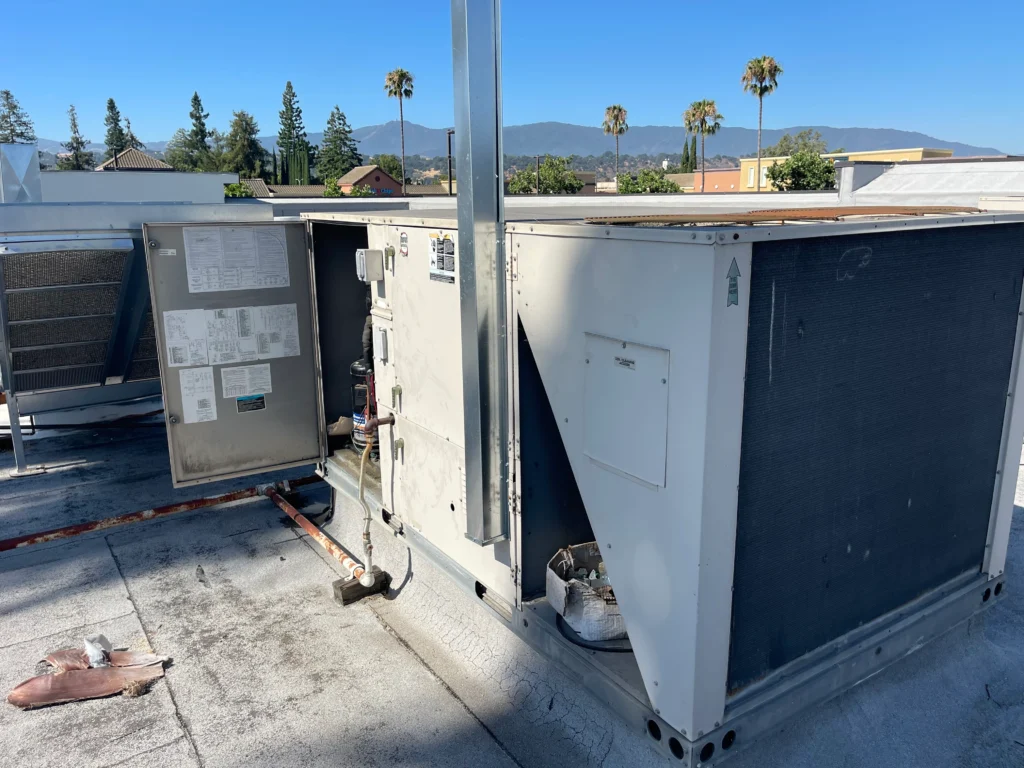Commercial HVAC System Replacement in the Bay Area
Table of Contents
Commercial HVAC System Replacement in the Bay Area
Your commercial HVAC system is the silent workhorse that keeps your business comfortable, productive, and profitable. But what happens when this critical equipment reaches the end of its useful life? Continuing to patch up an aging system becomes more expensive than replacement, while outdated technology wastes energy and compromises comfort.
The decision to replace your commercial HVAC system isn’t just about fixing what’s broken—it’s about upgrading to modern technology that reduces operating costs, improves reliability, and enhances your business environment. This guide reveals when replacement makes more sense than repairs, what advantages modern systems offer, and how the replacement process works.
Smart business owners recognize that strategic HVAC replacement is an investment that pays dividends through lower energy bills, fewer breakdowns, and improved working conditions for years to come.

Signs Your HVAC System Needs Replacement
Most commercial HVAC systems don’t fail suddenly—they gradually lose efficiency and require increasingly frequent repairs. Learning to recognize the warning signs helps you plan replacement before catastrophic failure disrupts your business operations.
Age alone doesn’t determine when replacement becomes necessary, but it’s a critical factor. Commercial HVAC systems typically last 15-20 years with proper maintenance. Systems approaching or exceeding this age range become candidates for replacement, especially when combined with other warning signs.
Frequent Breakdowns, Escalating Energy Costs, Age
Frequent breakdowns signal system deterioration that makes continued operation uneconomical. When repair calls become monthly rather than annual occurrences, your system is telling you it’s time for replacement. The general rule: if annual repair costs exceed 50% of replacement cost, replacement becomes the smarter financial choice.
Major component failures like compressor replacement, heat exchanger cracks, or electrical system overhauls often cost 60-80% of new system prices. When these expensive repairs combine with the system’s age, replacement typically offers better long-term value.
Escalating energy costs indicate declining efficiency that replacement can address immediately. Commercial HVAC systems lose efficiency gradually—often so slowly that rising energy bills seem normal. Comparing current energy usage to historical data reveals this hidden cost increase.
Systems installed before 2000 typically operate at 8-10 SEER efficiency levels, while modern units achieve 15-20 SEER or higher. This efficiency difference represents 30-50% higher energy consumption for the same cooling output. For businesses spending $15,000 annually on HVAC energy costs, this inefficiency represents $4,500-$7,500 in unnecessary expenses.
System age becomes critical when combined with maintenance challenges. Older systems face parts availability issues that extend repair times and increase costs. Manufacturers discontinue support for systems over 15 years old, making repairs more complex and expensive.
Aging systems also lack modern safety features and environmental compliance standards. R-22 refrigerant phase-out affects older systems, making refrigerant replacement expensive and eventually impossible. New systems use environmentally friendly refrigerants that cost less and perform better.
Building code changes may require upgrades during major repairs, adding unexpected costs to aging systems. Replacement ensures compliance with current standards while avoiding future regulatory complications.
Advantages of Replacing vs. Repairing
The repair-versus-replace decision involves more than comparing immediate costs. Modern HVAC technology offers significant advantages that make replacement the smart long-term choice for most aging commercial systems.
Financial analysis should consider total cost of ownership, not just upfront expenses. While repairs seem less expensive initially, recurring problems and higher operating costs often make replacement more economical within 2-3 years.
New Technology, Warranty, Efficiency, Lower Utilities
New technology transforms commercial HVAC performance through advanced features unavailable in older systems. Variable speed compressors adjust output to match actual demand, reducing energy consumption while maintaining consistent temperatures. Smart thermostats and building automation integration optimize operations based on occupancy schedules and weather conditions.
Modern systems include diagnostic capabilities that detect problems before they cause failures. These early warning systems reduce emergency repairs and extend equipment life through proactive maintenance. Older systems lack this predictive capability, making failures unpredictable and costly.
Comprehensive warranties provide peace of mind and financial protection that aging systems can’t match. New commercial HVAC systems include manufacturer warranties covering major components for 5-10 years, plus workmanship warranties from professional installers.
Warranty coverage eliminates unexpected repair expenses during the most vulnerable years of system operation. This protection contrasts sharply with aging systems where every component failure results in out-of-pocket expenses. Extended warranty options provide even longer protection for businesses prioritizing predictable operating costs.
Energy efficiency improvements deliver immediate and ongoing savings that help offset replacement costs. Modern commercial HVAC systems achieve efficiency levels that were impossible just a decade ago. SEER ratings of 15-20 represent substantial improvements over older systems rated at 8-10.
Variable speed technology, improved heat exchangers, and advanced refrigerants work together to reduce energy consumption by 30-50% compared to systems installed before 2000. For businesses with annual HVAC energy costs of $20,000, this efficiency improvement saves $6,000-$10,000 annually.
Lower utility costs provide measurable returns on replacement investment. Modern systems not only use less energy but also qualify for utility rebates and tax incentives that reduce net replacement costs. Many utilities offer substantial rebates for high-efficiency commercial installations, sometimes covering 10-20% of total project costs.
Time-of-use electricity rates make efficiency even more valuable. New systems can shift operations to avoid peak demand periods, reducing both energy consumption and demand charges. This capability can save thousands annually for businesses subject to demand-based pricing.
Improved power factor correction in modern systems reduces electrical penalties while improving overall electrical system efficiency. These often-overlooked benefits add to total energy savings and improve return on investment calculations.

Our HVAC Replacement Process
Professional HVAC replacement requires careful planning, precise execution, and thorough testing to ensure optimal performance. The replacement process affects business operations, so experienced contractors work efficiently while minimizing disruption.
Understanding the replacement process helps you prepare appropriately and set realistic expectations for timing and coordination requirements. Most commercial replacements take 3-7 days, depending on system complexity and building requirements.
Evaluation, Customized Plan, Removal, Professional Install
Comprehensive evaluation begins with detailed assessment of your current system, building requirements, and business needs. Professional contractors examine existing equipment, ductwork condition, electrical capacity, and structural considerations that affect replacement planning.
Load calculations ensure proper system sizing for your specific building characteristics. These calculations consider square footage, insulation levels, window placement, occupancy patterns, and equipment heat loads. Proper sizing is crucial—oversized systems waste energy while undersized units can’t maintain comfort during peak demand.
Site evaluation identifies potential complications like difficult access routes, structural modifications needed, or electrical upgrades required. Addressing these issues during planning prevents surprises and delays during installation.
Customized replacement plans address your specific requirements while optimizing performance and efficiency. Professional contractors recommend systems based on your building’s needs, budget constraints, and operational priorities.
Equipment selection considers factors beyond initial cost, including long-term efficiency, maintenance requirements, and expansion capabilities. Contractors explain options and trade-offs, helping you make informed decisions about features and capabilities.
Project timelines account for equipment delivery, permit approvals, and coordination with your business schedule. Detailed plans minimize operational disruption while ensuring quality installation.
Safe equipment removal includes proper disposal of old equipment and refrigerants according to environmental regulations. Professional contractors handle all aspects of removal, including disconnection, rigging, and disposal.
Refrigerant recovery prevents environmental damage while complying with EPA regulations. Improper refrigerant handling carries substantial penalties, making professional removal essential.
Old equipment disposal includes recycling valuable materials like copper and aluminum while ensuring environmentally responsible handling of other components.
Professional installation follows systematic procedures that ensure optimal performance and code compliance. Experienced crews work efficiently while maintaining quality standards that guarantee long-term reliability.
Installation includes equipment placement, electrical connections, ductwork modifications, control system programming, and comprehensive testing. Every connection is verified, and system performance is documented before completion.
Thorough commissioning ensures all components operate correctly and efficiently. This process includes airflow balancing, temperature calibration, and control system programming for optimal performance.

Emergency HVAC Issues We Fix
Your system may need urgent attention if you’re experiencing:
- No airflow from vents
- Furnace blowing cold air
- AC blowing warm air
- System won’t turn on
- Iced-over AC or refrigerant line
- Thermostat not responding
- Loud, unusual noises from the unit
- Weak airflow or poor indoor air quality
- Water leaks around the unit
- Burning smells or electrical odor
- Complete system failure
If you notice any of these signs, don’t wait. Contact COOL AID for immediate HVAC help.
Cost Transparency & Satisfaction Guarantee
Commercial HVAC replacement represents a significant investment that requires clear understanding of costs and expectations. Professional contractors provide transparent pricing that helps you budget effectively while ensuring value for your investment.
Hidden costs and surprise charges undermine trust and complicate financial planning. Reputable contractors provide detailed estimates that explain exactly what’s included and identify any potential additional costs.
Clear Estimates & Licensed Technicians for Peace of Mind
Detailed cost estimates break down all project expenses including equipment, installation labor, permits, and ancillary services. Professional contractors explain what each cost covers and identify any assumptions that affect pricing.
Equipment costs should specify exact models and capabilities, not generic descriptions. This specificity helps you compare options and understand value propositions. Installation costs should cover all labor required for complete system commissioning.
Permit and inspection fees vary by location and project scope. Professional contractors handle all permit applications and coordinate inspections, ensuring compliance with local building codes.
Financing options make replacement affordable while preserving working capital for other business needs. Many contractors offer financing programs with competitive rates and flexible terms. Energy savings from efficient new systems often offset monthly payments, making upgrades cash-flow positive from day one.
Utility rebate programs reduce net project costs significantly. Professional contractors stay current on available incentives and help you navigate application processes to maximize savings.
Licensed technicians provide assurance that replacement work meets professional standards and code requirements. Commercial HVAC work requires specific licenses that demonstrate competency with complex systems and safety requirements.
Proper licensing protects your business from liability while ensuring quality workmanship. Licensed contractors carry appropriate insurance coverage and stand behind their work with comprehensive warranties.
Satisfaction guarantees demonstrate confidence in workmanship and equipment performance. Professional contractors guarantee their installations and provide prompt resolution for any performance issues.
Written guarantees specify exactly what’s covered and for how long. These commitments provide peace of mind and ensure accountability for long-term system performance.
Quality contractors also provide ongoing support through maintenance programs, priority service, and technical assistance. This support protects your investment and ensures continued satisfaction with your new system.

Transform Your Business with Modern HVAC Technology
Your commercial HVAC system affects every aspect of your business, from employee comfort to operating costs to environmental impact. Replacing an aging system with modern technology positions your business for years of efficient, reliable climate control.
Don’t let an outdated HVAC system drain your profits or compromise your operations. Modern replacement systems offer immediate improvements in efficiency, reliability, and comfort that pay dividends for decades.
The advantages of replacement over continued repairs become more compelling as systems age. While repairs address immediate problems, replacement solves underlying issues while providing modern capabilities that improve your business environment.
Ready to explore commercial HVAC replacement for your Bay Area business? Contact 1800coolaid.com today for a comprehensive system evaluation and customized replacement plan. Our licensed technicians provide transparent pricing, guaranteed satisfaction, and the expertise your business needs to make the smart choice for long-term success. Don’t wait until system failure disrupts your operations—take control with professional HVAC replacement services you can trust.
Frequently Asked Questions
How do I know if my commercial HVAC system needs replacement instead of repair?
Consider replacement when annual repair costs exceed 50% of replacement cost, when your system is over 15 years old with declining efficiency, or when major components like compressors or heat exchangers fail. We provide cost-benefit analysis to help you make the right decision.
What energy savings can I expect from a new commercial HVAC system?
Modern systems typically reduce energy consumption by 30-50% compared to units installed before 2000. For a business spending $15,000 annually on HVAC energy, this represents $4,500-$7,500 in yearly savings, often paying for replacement within 3-5 years.
How long does commercial HVAC replacement take and will it disrupt my business?
Most commercial replacements take 3-7 days depending on system complexity. We work around your schedule to minimize disruption and can often provide temporary climate control during installation to keep your business operational.
Serving the Entire Bay Area
We proudly serve customers in:
